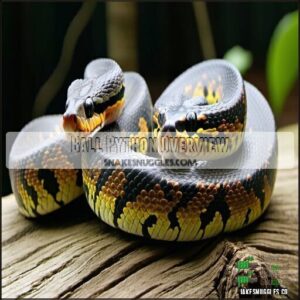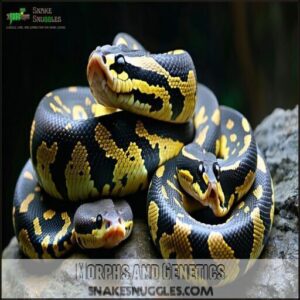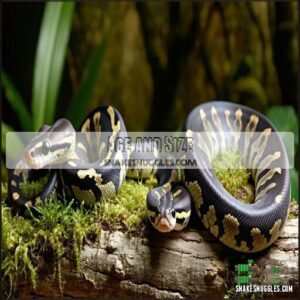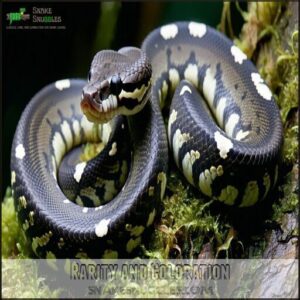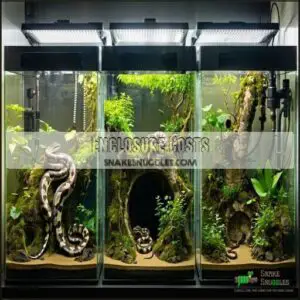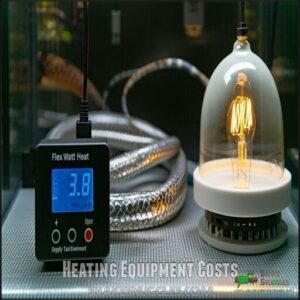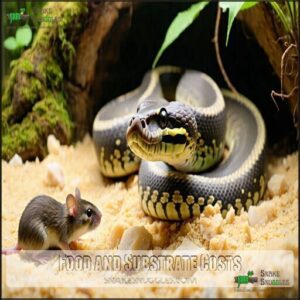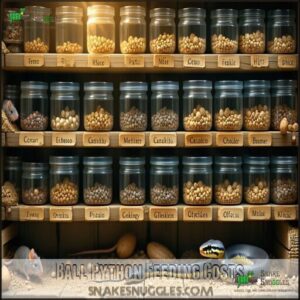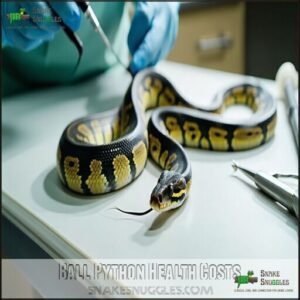This site is supported by our readers. We may earn a commission, at no cost to you, if you purchase through links.

Most typical ball pythons range from $50 to $450, making them popular, affordable pets.
If you’re eyeing rare morphs like albinos or piebalds, prices can stretch to $500-$10,000.
Factors like age, size, and breeding potential also play a role—adult females, known for producing clutches, are pricier.
Don’t forget initial setup costs for their habitat and care! Before committing, consider your budget and research thoroughly.
After all, no one wants a snake-sized dent in their wallet!
Table Of Contents
- Key Takeaways
- Ball Python Overview
- Ball Python Price Range
- Factors Affecting Price
- Ball Python Care Costs
- Ball Python Feeding Costs
- Ball Python Health Costs
- Minimizing Ball Python Costs
- Research and Comparison
- Adoption and Rescue
- DIY Habitat Setup
- How Big Do Ball Pythons Get?
- How Much Does a Ball Python Cost?
- How Much Does an Albino Ball Python Cost?
- How Much Does a Black Eyed Ball Python Cost?
- How Much Does a Ball Python Morph Cost?
- How Much Does a Ball Python Habitat Cost?
- Are Ball Pythons Good Pets?
- Do Ball Pythons Bite as Pets?
- How Much Does a Pied Ball Python Cost?
- Do You Need a License to Own a Ball Python?
- Frequently Asked Questions (FAQs)
- How big do ball pythons get?
- How much does a ball python cost?
- How much does a ball python cost in 2025?
- How much does a black eyed ball python cost?
- How much does a clown ball python cost?
- How much does an albino ball python cost?
- How long do ball pythons typically live?
- Can ball pythons recognize their owners?
- What is the best bedding for ball pythons?
- How do you safely handle a ball python?
- Conclusion
Key Takeaways
- You’ll pay $50 to $10,000 for a ball python, depending on morph, age, and size, with most typical options priced between $100 and $500.
- Rare morphs, like albinos or Killer Clowns, can cost thousands due to unique genetics and limited availability.
- Initial setup costs for enclosures, heating, and habitat range from $250 to $800, plus $30 to $100 monthly for food and care.
- Buying from ethical breeders or adopting from rescues can save money while ensuring the snake is healthy and properly cared for.
Ball Python Overview
You’ll find ball pythons priced between $50 and $20,000 depending on their age, size, and genetic morph, with most costing $100 to $500 for standard varieties.
While wild-type patterns are more affordable, rare color morphs like sunset ($1,300-$2,600) or GHI ($2,900-$4,200) can cost substantially more due to their unique genetics and limited availability.
Ball Python Characteristics
The ball python (Python regius) showcases distinctive characteristics that attract snake enthusiasts worldwide.
Their docile temperament makes them perfect for beginners and experts alike.
Perfect for beginners and experts, their calm temperament and manageable size make ball pythons a joy to own.
When choosing your pet snake, you’ll notice:
- Impressive lifespan expectancy of 25-30 years with proper care
- Size variation typically reaching 3-5 feet at maturity
- Pattern diversity with hundreds of stunning morphs available
- Handling ease due to their calm nature and compact, muscular build
Their manageable size and gentle personality explain why they’re America’s most popular pet snake.
Ball Python Behavior
Beyond their physical traits, what makes ball pythons exceptional pets is their docile temperament.
Their calm demeanor and gentle nature make ball pythons one of the easiest and most enjoyable pet snakes to care for.
You’ll notice they curl into a defensive ball when stressed—earning their name.
These reptiles are primarily nocturnal, with most activity patterns occurring at dusk and dawn.
Handling stress is minimal with proper socialization, though they prefer limited social interaction.
Their calm nature and predictable behavior make them ideal snakes for beginners and experienced keepers alike.
Proper enclosure setup, including maintaining the correct temperature gradient, is essential for a relaxed pet.
Ball Python Habitat
While your ball python’s behavior tells you about their personality, their habitat shapes their health and happiness.
Your snake needs a properly sized enclosure—40+ gallons for adults, 10-20 gallons for juveniles.
Native to West African savannas, these reptiles thrive with a temperature gradient (95°F warm side, 78°F cool side) and multiple hiding spots that provide security.
You’ll need quality substrate options, a secure screened lid, and proper humidity control (50-60%) to recreate their natural environment.
Remember to include a water dish large enough for soaking but not too deep for safety, and provide a suitable environment for your pet.
Ball Python Price Range
Now that you know what ball pythons are like, let’s talk money. You’ll find ball python prices vary widely in 2025, ranging from $50 for basic varieties to a whopping $10,000 for the rarest specimens.
Most pet owners spend between $59-$450 for their slithery friend. If you’re budget-conscious, consider adoption fees of $25-$100 at rescues.
Expect to pay:
- $50-$150 for hatchlings
- $150-$400 for juveniles
- $250-$1,500 for adults
Adult females command higher prices ($800-$1,000) than males ($400-$600) due to breeding potential.
The wild-type ball python cost starts around $40, while rare morphs like Killer Clowns ($1,600-$2,100) or GHI morphs ($2,900-$4,200) will empty your wallet faster than you can say "snake!"
Your location matters too—prices in the snake price guide fluctuate based on breeder availability and regional demand for specific ball python morph varieties.
Factors Affecting Price
You’ll find that your ball python’s price tag is influenced by several key factors including genetics, age, size, and rarity.
Whether you’re eyeing a basic $50 snake or saving up for that $10,000 designer morph, understanding these price variables will help you make a smart purchase.
Morphs and Genetics
Pricing ball pythons becomes fascinating when genetics enter the picture. With ball python morphs exhibiting the most genetic variation on Earth, your choice affects both appearance and cost.
Morph Popularity drives prices substantially:
- Dominant Traits like Pinstripe show immediately ($100-175)
- Recessive Genes require both parents carrying them ($200+)
- Designer Morphs combining multiple genetics can reach $10,000
- Visual Genetics in rare combinations create one-of-a-kind snakes
From classic wild-types ($40-80) to exclusive GHI morphs ($2,900-4,200), your snake’s designer "paint job" determines its price tag.
Age and Size
While morphs affect price, a ball python’s age and size also determine its value.
| Growth Stage | Size/Weight | Price Range |
|---|---|---|
| Hatchling | 10-16 inches, 45-80g | $50-$150 |
| Juvenile | 16-24 inches, 500-1000g | $150-$400 |
| Adult | 2-5 feet, 1200-2500g | $250-$1,500 |
| Female Adult | Typically larger | $800-$1,000 |
Adult females cost nearly double males due to their breeding potential.
Rarity and Coloration
Stunning coloration can catapult your ball python’s price tag into premium territory. The impact of rarity on ball python morph costs is substantial, with wild-type prices starting at just $50 while designer morphs fetch thousands.
Three factors that dramatically influence snake morph price:
- Morph popularity – high-demand varieties like piebald command higher prices
- Color genetics – recessive traits like albinism increase value
- Pattern uniqueness – the more unusual the pattern, the higher the cost
Obscure morphs with spectacular color combinations often become the most valuable ball python morphs available, showcasing the significant effect of rarity and color genetics on their price.
Ball Python Care Costs
You’ll need to budget between $250-800 for initial setup costs beyond the snake’s purchase price.
Your ongoing monthly expenses will run about $30-100 for food, substrate, and occasional vet visits, making ball pythons surprisingly affordable pets in the long run, with monthly expenses being relatively low.
Enclosure Costs
While morph pricing catches your eye, the enclosure is where the real investment happens for your ball python’s home.
A proper ball python habitat will cost:
- Small starter tank (20-gallon): $70-$200, suitable for juveniles
- Standard adult enclosure (40-gallon): $150-$300, providing adequate space
- Premium terrarium (60+ gallon): $300-$450, giving your snake luxury accommodations
Don’t forget to budget for substrate choices, hide varieties, and tank accessories! Adult ball pythons need larger enclosures.
DIY enclosures can save money if you’re handy with tools.
Heating Equipment Costs
What exactly does it cost to keep your scaly friend comfortable? Your ball python’s heating setup is essential for their health.
Under tank heaters typically run $25-$40, while Flex Watt Heat Tape costs just $3-$5 per foot.
A good thermostat ($45-$100+) prevents overheating—it’s non-negotiable for heat mat safety!
Ceramic heat emitters ($20-$30) and heat lamps ($8-$12) provide alternative heating options with varying energy consumption depending on bulb types.
Many owners purchase reptile heating supplies online.
Food and Substrate Costs
While your heating setup keeps your ball python cozy, food and substrate are recurring costs you’ll need to budget for.
Most owners spend about $2 weekly feeding young pythons and $4 for adults. Consider prey size carefully—your snake’s diet should grow with them!
Substrate costs typically run $50-$70 annually, with cleaning frequency affecting how often you’ll replace it. Sphagnum moss adds another $20 yearly. A good choice, like coconut fiber, aids burrowing.
Looking to reduce expenses? Many keepers find cost-saving food options by buying frozen mice in bulk rather than live ones, which is safer for your snake anyway, and consider buying in bulk to minimize recurring costs.
Ball Python Feeding Costs
You’ll need to budget $130-350 annually for your ball python’s meals, with young snakes eating $1-2 mice and adults requiring $4-15 rats per feeding.
Your snake’s feeding costs will vary based on size, age, and local prices, but you’ll find that proper meal planning prevents both hunger in your pet and emptiness in your wallet, which is a key aspect of responsible pet ownership and budgeting.
Feeding Frequency
Feeding your ball python depends on its age, size, and activity.
Here’s how feeding frequency works:
- Hatchlings (under 6 months): Offer prey every 5-7 days.
- Juveniles (6 months-3 years): Feed every 7-10 days.
- Adult males: Provide meals every 10-14 days.
- Adult females: Feed every 14-21 days.
- Breeding females: Weekly meals during the breeding season prevent weaknesses.
Stick to this schedule to avoid obesity risks or regurgitation causes!
Food Types and Quality
Food quality is key to a healthy snake diet.
Stick to prey size that matches your ball python’s age, whether frozen vs. live.
Frozen rodents, especially from a reliable food source, are safer, economical, and maintain nutritional value.
Gut-loading feeders before freezing boosts nutrition.
Prioritize food requirements by choosing quality prey over cheap options—your python (and wallet) will thank you, as this ensures a healthy snake diet.
Feeding Schedule
A proper feeding schedule keeps your ball python healthy and happy without stressing your wallet.
Timing depends on their age:
- Hatchlings: Weekly pinkie mice (small prey size avoids regurgitation issues).
- Juveniles: Feed every 7–10 days.
- Young Adults: Offer meals like small rats every 10–14 days.
- Adults: Every 14–21 days suits their slower metabolism.
- Breeding Females: Increase feeding frequency to support growth.
Remember these tips for your snake’s feeding schedule:
- Always match prey size to the widest part of your snake.
- Skip meals if your snake seems uninterested (snakes self-regulate diets).
- Don’t overfeed, avoiding health or regurgitation issues.
- Stick to consistent feeding frequency for stress-free digestion.
- Watch for signs of hunger or weight changes.
Ball Python Health Costs
Keeping your ball python healthy isn’t expensive, but it does require some planning. From yearly vet checkups to potential treatments, understanding these costs will help you avoid surprises.
Veterinary Care
Keeping your ball python healthy means planning for regular vet checkups and preventative care. Annual checkups average $7 monthly, catching issues before they spiral.
Emergency care, while rare, can spike costs. Exotic insurance can help cover these surprises.
Most snakes face common ailments like respiratory infections, easily treatable with timely snake medical care.
Here’s a quick cost breakdown:
| Service | Frequency | Average Cost | Monthly Equivalent | Purpose |
|---|---|---|---|---|
| Vet Checkups | Annually | $75-$100 | $6-$8 | Preventative Care |
| Emergency Care | As Needed | $100-$500+ | Varies | Immediate Treatment |
| Reptile Insurance | Monthly | $15-$20 | $15-$20 | Insurance Coverage |
| Common Ailment Care | As Needed | $50+ | Varies | Medical Costs |
| Routine Tests | Annually | $50-$75 | $4-$6 | Health Assessment |
The table outlines the average cost and frequency of various services, including vet checkups, emergency care, reptile insurance, common ailment care, and routine tests. Understanding these costs can help you plan for your ball python’s medical care and ensure you provide the best possible health care for your pet.
Medical Expenses
Unexpected medical expenses can pop up when your ball python faces health challenges.
Common ailments like respiratory infections or shedding issues might lead to emergency visits costing $100-$300.
Medications can range from $20-$80 depending on the condition, and parasite treatments typically fall between $75-$150.
Regular preventative care helps, but it’s wise to keep a $500 “rainy day” fund for emergencies to ensure your snake receives proper treatment.
Snake medical care through exotic vets guarantees your scaly friend stays healthy and happy!
Insurance Options
Treating your ball python can add up quickly, but did you know snake insurance is a thing? Reptile-specific plans in 2025 can help ease unexpected vet bills—and they’re more common than you’d think!
Whether you’re protecting a pricey morph or just playing it safe, you’ve got options:
- Coverage Types: Emergency care, wellness, or theft protection.
- Policy Costs: Balances premium vs. benefit.
- Claim Process: Smooth or stressful? Check reviews.
- Exclusions Explained: Know the fine print.
- Choosing Insurer: Research before committing!
Premiums can vary, but pet insurance helps manage emergency medical expenses.
Why stress? Protect your slithery pal!
Minimizing Ball Python Costs
You don’t have to empty your wallet to care for a ball python if you’re smart about costs.
With some research, creative solutions, and careful planning, you can keep expenses low while still meeting your snake’s needs.
Research and Comparison
When you compare prices for ball pythons, research the Seller Reputation and check for Health Guarantees.
Morph Values can cause substantial Cost Fluctuations, so browsing multiple breeders guarantees you spot the best deals.
Local breeders often beat online prices, and Ethical Breeders prioritize healthy, well-cared-for snakes.
Ball python prices range widely; screen for quality and variety to find the perfect python within budget!
Adoption and Rescue
Adopting a ball python through a rescue is a budget-friendly, feel-good option.
Adoption costs range from just $25 to $100, far less than buying from a breeder or pet store.
Rescues emphasize ethical considerations, guaranteeing the snake received proper care.
Plus, you’ll often get guidance on husbandry!
While adoption benefits your wallet, rescue challenges, like a screening process, confirm you’re ready.
Find local snake rescues or shelters to give a rehomed python a second chance!
DIY Habitat Setup
Skip the expensive pet store options—craft a ball python habitat that’s both cost-effective and cozy! DIY habitat solutions are perfect for saving money while creating a safe snake enclosure.
Here are five practical ideas:
- Repurpose sturdy plastic tubs ($15-$20) as a budget-friendly snake enclosure.
- Use household items like cardboard or small containers as homemade hides.
- Mix coconut fiber with cypress mulch for a custom, natural-looking substrate.
- Assemble heating with affordable heat tape and a thermostat for automated systems.
- Enhance aesthetics with cost-effective designs, such as custom backgrounds made from washable materials.
Providing a secure space is essential, so consider exploring options for quality python enclosures.
How Big Do Ball Pythons Get?
Ball pythons don’t take up much room, but their size varies.
Adults reach 3-5 feet, depending on genetics and sex. Females are generally larger than males, and their weight factors into enclosure size decisions.
Knowing their average growth rates can help owners plan accordingly. Juveniles grow quickly; a 40-gallon tank suits adults well.
Here’s a handy breakdown:
| Stage | Length | Average Weight | Enclosure Size |
|---|---|---|---|
| Hatchling | 10-17 in | 50-100 g | 10-20 gallons |
| Juvenile | 18-30 in | 100-500 g | 20-30 gallons |
| Sub-adult | 31-48 in | 500-1,500 g | 30-40 gallons |
| Adult | 36-60 in | 1,000-3,000 g | 40+ gallons |
How Much Does a Ball Python Cost?
A ball python’s price depends on age, size, and morph, ranging from $40 for a classic to $10,000 for rare designs.
Hidden expenses like enclosures and heating equipment add to the initial outlay.
Budgeting tips include adopting or buying younger snakes, which often cost less. Watching cost fluctuations can also help you snag the right python without overspending, and this can be a key factor in making a rare purchase.
How Much Does an Albino Ball Python Cost?
Albino ball python prices vary based on features like albino genetics and visual variations.
Expect costs in these ranges:
- Babies: $199-$300.
- Rare morphs: Over $500.
- Captive-bred options: $300-$450.
- Discounted deals: Around $200.
- Local breeders: Prices fluctuate.
Breeding albino morphs fuels demand, but their lifespan guarantees long-term value, making them a fascinating investment!
How Much Does a Black Eyed Ball Python Cost?
Black Eyed Ball Python prices range from $300 to $500, influenced by Black Eye Genetics and Eye Mutation Impact.
Their Visual Appeal Value stems from all-white scales and striking black eyes. Breeder Reputation matters, ensuring proper health and Unique Traits.
Check the table below for pricing examples:
| Morph Type | Price Range | Notes |
|---|---|---|
| Hatchling | $300-$399 | Lower ball python price |
| Juvenile | $400-$449 | Higher morph value |
| Adult Male | $350-$450 | Limited breeding use |
| Adult Female | $400-$500 | Valuable for breeding |
| Specialty | $500+ | Rare black eyed morph |
How Much Does a Ball Python Morph Cost?
Morph rarity, color intensity, and pattern uniqueness play huge roles in ball python morph prices.
Costs vary widely, from $100 for simpler morphs to $10,000+ for rare designer morphs prized by collectors.
Some morphs worth exploring:
- Pastel morphs: Affordable at $100-$175.
- Sunset morphs: Eye-catching but pricey at $1,300-$2,600.
- GHI morphs: Stunning, reaching $2,900-$4,200!
How Much Does a Ball Python Habitat Cost?
Setting up a ball python habitat costs $250–$800, depending on your choices.
A well-sized enclosure starts at $70, while heating costs and substrate options add $50–$150.
Hide variety ranges from $10–$30 each.
Automation systems make controlling humidity a breeze but increase costs.
A proper setup guarantees comfort, making your snake happy and reducing long-term maintenance headaches.
Are Ball Pythons Good Pets?
Ball pythons make great pets, especially for beginners.
Their handling ease and calm temperament ease any worries about owning a snake. These snakes are space-efficient, needing minimal room compared to other reptiles.
Family-friendly and low maintenance, a ball python’s pet cost, including setup and care, is manageable. It’s a small investment for a reptile pet packed with charm and calm temperament!
Do Ball Pythons Bite as Pets?
Ball pythons rarely bite as pets, thanks to their calm temperament.
Bites usually stem from defensive behavior, not aggression.
Proper handling techniques can minimize bite frequency, ensuring your pet snake feels secure.
If bitten, the severity is typically minor—more startling than painful!
Always respect your ball python’s boundaries, and you’ll build trust with this gentle snake.
How Much Does a Pied Ball Python Cost?
Pied ball pythons are a stunning choice, thanks to their unique pattern variations and Pied genetics.
These beauties typically cost $300 to $1,000, depending on breeder reputation and Pied demand.
If you’re eyeing investment potential, higher-quality specimens command even more, their rarity often boosts their ball python price, making them a standout in any ball python morph guide!
Do You Need a License to Own a Ball Python?
Wondering if you need a license to own a ball python? It depends on your location.
While most regions don’t require permits, some states have strict exotic pet bans or breeder requirements.
Always check local regulations and federal laws before buying your new pet.
- Research local laws for ownership rules.
- Check state permits for restricted pets.
- Understand exotic pet bans in your area.
- Verify breeder requirements for legal purchases.
Frequently Asked Questions (FAQs)
How big do ball pythons get?
They typically grow 3 to 5 feet long, with females often being larger than males.
While they’re smaller compared to other python species, their thick bodies mean they still command respect—call them your “compact giants”!
How much does a ball python cost?
You’ll pay anywhere from $50 to $10,000 for a ball python, depending on its age, size, and morph. Most cost $100 to $500, but rare or designer morphs can skyrocket the price.
How much does a ball python cost in 2025?
In 2025, ball python prices range widely from $50 to $10,000, based on age, size, and unique morphs. Common options cost $100 to $500, while rare or designer morphs push the high-end limits.
How much does a black eyed ball python cost?
Black-eyed ball pythons, a rare and stunning morph, often cost between $3,000 and $10,
Pricing depends on genetics, rarity, and quality.
If you’re after this beauty, research breeders carefully for authenticity and care support.
How much does a clown ball python cost?
Clown ball pythons usually cost between $200 and $600, depending on age, size, and quality of the morph.
Their unique, bold patterns make them a popular choice, offering great visual appeal for collectors and enthusiasts alike, with their unique appeal being a major factor.
How much does an albino ball python cost?
You’ll typically find albino ball pythons priced between $300 and $500, depending on age, size, and markings.
Since they’re visually striking, albinos are a popular choice and a great addition to collections.
How long do ball pythons typically live?
Think of them as the tortoises of snakes—ball pythons can live 20 to 30 years with proper care.
Some even hit 40, making them a long-term companion if you’re ready for the commitment!
Can ball pythons recognize their owners?
Ball pythons can’t recognize you like a dog might, but they can get used to your scent, touch, and routines.
Over time, they’ll tolerate handling and seem more relaxed around you.
What is the best bedding for ball pythons?
A cozy home begins with the right bedding—cypress mulch, aspen shavings, or coconut husk work best.
They maintain humidity, prevent odors, and keep your ball python happy.
Avoid cedar or pine, which can be toxic.
How do you safely handle a ball python?
Always support your ball python’s body, lifting from below while avoiding sudden movements.
Let it explore your hands naturally.
Don’t handle right after feeding or shedding, as that can stress the snake.
Stay calm!
Conclusion
Just like royalty in ancient myths, ball pythons can be as affordable or extravagant as you want, depending on their morphs and rarity.
A typical ball python costs $50 to $450, while rare morphs like albinos might hit $10,000.
Don’t forget setup and care costs, which can add up quickly.
If you’re wondering how much is a ball python, focus on research and a well-planned budget to guarantee you’re ready for this fascinating pet.
- https://en.wikipedia.org/wiki/Captive_breeding
- https://www.ncbi.nlm.nih.gov/pmc/articles/PMC3118381/
- https://www.xyzreptiles.com/how-much-does-a-ball-python-cost/
- https://reptiles.pets.narkive.com/cHBmhiiC/ball-python-enclosure-prices
- https://www.quora.com/What-is-the-typical-total-cost-of-a-ball-python-terrarium-food-substrates-hides-branches-and-fake-leaves

